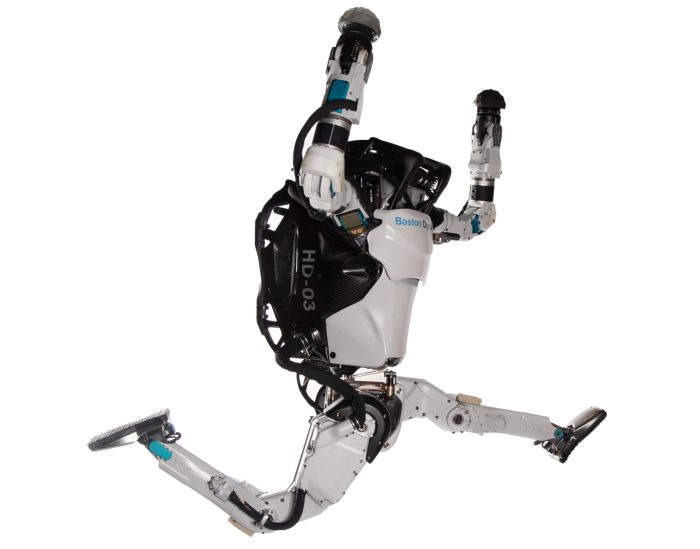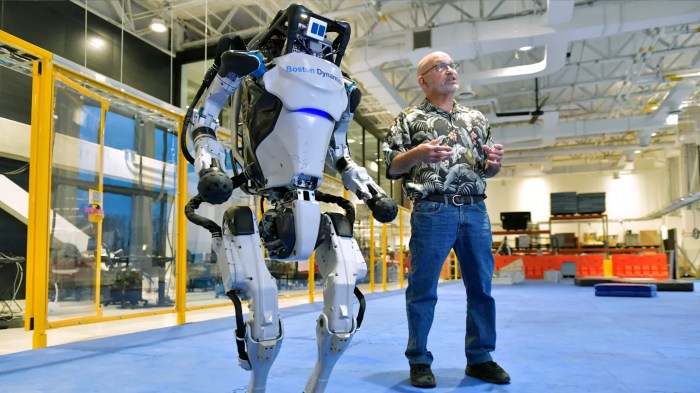Boston Dynamics Atlas Humanoid Robot Goes Electric: Prepare to be amazed as we dive into the electrifying evolution of Boston Dynamics’ Atlas, the humanoid robot that’s pushing the boundaries of robotics. From its hydraulic beginnings to its groundbreaking transition to electric power, Atlas has become a symbol of innovation, showcasing remarkable advancements in agility, efficiency, and potential applications across diverse industries.
The shift to electric power marks a significant milestone in Atlas’s journey, ushering in a new era of capabilities. This change not only enhances performance but also opens doors to a wider range of applications, making Atlas even more relevant in a world increasingly reliant on automation and robotics.
Boston Dynamics Atlas: A Giant Leap in Robotics: Boston Dynamics Atlas Humanoid Robot Goes Electric
Atlas, a humanoid robot developed by Boston Dynamics, stands as a testament to the remarkable progress in robotics. Its advanced capabilities and potential applications have garnered significant attention, making it a key player in shaping the future of this field.
History and Development of Atlas
Atlas’s journey began in 2013, when Boston Dynamics, then a subsidiary of Google, unveiled the first prototype. This initial version was designed for participation in the DARPA Robotics Challenge, a competition aimed at developing robots capable of assisting humans in disaster relief scenarios. Since then, Atlas has undergone continuous development, undergoing significant upgrades in terms of its hardware, software, and capabilities.
- DARPA Robotics Challenge (2013-2015): Atlas’s early development was heavily influenced by its participation in the DARPA Robotics Challenge. This competition pushed the boundaries of robotic dexterity, requiring robots to perform tasks such as driving a vehicle, opening doors, and navigating complex terrains. Atlas’s performance in the challenge showcased its potential for real-world applications.
- Acquisition by Hyundai (2021): In 2021, Hyundai Motor Group acquired Boston Dynamics, marking a significant shift in the company’s trajectory. This acquisition brought together Hyundai’s expertise in automotive manufacturing and robotics with Boston Dynamics’ cutting-edge technology. The move is expected to accelerate the development and deployment of Atlas and other Boston Dynamics robots in various industries.
Capabilities of Atlas
Atlas is a highly sophisticated humanoid robot that possesses a range of impressive capabilities. Its advanced design and software enable it to perform tasks that were once considered exclusive to humans.
- Dynamic Locomotion: Atlas can navigate complex terrains with agility and balance. It can walk, run, jump, and even perform backflips, showcasing its remarkable dexterity and coordination. This ability allows it to operate in environments that are challenging for traditional robots.
- Object Manipulation: Atlas is equipped with dexterous hands that allow it to manipulate objects with precision. It can grasp, lift, and carry objects of various shapes and sizes. This capability is crucial for tasks that require fine motor skills, such as opening doors, operating tools, and assembling components.
- Perception and Navigation: Atlas is equipped with advanced sensors that provide it with a comprehensive understanding of its surroundings. These sensors include cameras, lidar, and depth sensors, enabling it to perceive objects, navigate obstacles, and make informed decisions in real-time.
- Autonomous Operation: Atlas can operate autonomously, making decisions and executing tasks without human intervention. Its advanced software algorithms allow it to plan and execute complex sequences of actions, making it suitable for applications that require independence and adaptability.
Technological Advancements in Electric Atlas
The electric Atlas, a revolutionary step in humanoid robotics, boasts significant advancements in battery technology, electric motors, and control systems. These innovations enable the robot to perform complex tasks with enhanced agility and endurance.
Battery Technology
The electric Atlas utilizes a cutting-edge battery technology that provides extended operating time and increased power density. This battery system is optimized for high-performance applications, allowing the robot to perform demanding tasks for longer durations without needing frequent recharging. The battery is designed to be lightweight and compact, minimizing its impact on the robot’s overall mobility and agility.
Electric Motors and Actuators
The electric Atlas features highly efficient electric motors and actuators that deliver exceptional power and precision. These motors are designed to operate at high speeds and provide precise control over the robot’s movements. The actuators, responsible for converting electrical energy into mechanical motion, are optimized for high torque and responsiveness, allowing the robot to execute complex maneuvers with agility.
Control Systems and Software
The electric Atlas relies on advanced control systems and software that enable precise and coordinated movements. These systems process sensor data in real-time, allowing the robot to adapt to its environment and perform complex tasks with accuracy. The software algorithms are designed to ensure smooth and efficient operation, enabling the robot to navigate challenging terrains and perform tasks with dexterity.
Impact of Electric Power on Atlas’s Abilities
The transition from hydraulics to electric power has profoundly transformed Atlas’s capabilities, enhancing its agility, maneuverability, and overall performance. This shift unlocks new possibilities for Atlas’s applications, impacting various industries and pushing the boundaries of robotics.
Enhanced Agility and Maneuverability
The switch to electric power has significantly improved Atlas’s agility and maneuverability, making it a more versatile and dynamic robot. Electric motors are lighter and more responsive than hydraulic systems, allowing for quicker and more precise movements.
Electric motors offer a higher power-to-weight ratio, enabling Atlas to move with greater speed and agility.
This enhanced agility is crucial for navigating complex environments and performing tasks that require precise movements, such as manipulating objects or traversing uneven terrain.
New Tasks and Applications
The increased agility and efficiency of electric Atlas opens doors to a wider range of tasks and applications.
The ability to move more quickly and precisely allows Atlas to perform tasks that were previously impossible for its hydraulic predecessor.
For instance, electric Atlas can now perform more complex tasks in manufacturing, such as assembling intricate products or handling delicate materials.
- In construction, electric Atlas can assist with tasks like bricklaying, welding, and demolition, improving safety and efficiency.
- In search and rescue operations, electric Atlas can navigate treacherous environments and provide critical assistance in disaster zones.
These new applications demonstrate the potential of electric Atlas to revolutionize various industries and improve human lives.
Potential Impact on Industries, Boston dynamics atlas humanoid robot goes electric
The electric Atlas has the potential to revolutionize various industries by improving efficiency, safety, and productivity.
The versatility and adaptability of electric Atlas make it a valuable asset for various industries, from manufacturing to healthcare.
- In manufacturing, electric Atlas can automate tasks, reducing human error and improving production efficiency.
- In healthcare, electric Atlas can assist with patient care, providing support and assistance to medical professionals.
- In logistics, electric Atlas can handle tasks such as loading and unloading cargo, optimizing efficiency and reducing labor costs.
The widespread adoption of electric Atlas could lead to significant economic growth and job creation, while also improving the quality of life for many people.
As Atlas continues to evolve, its electric power system promises to fuel a future where robots seamlessly integrate into our lives, transforming industries and pushing the boundaries of what’s possible. The potential applications are vast, ranging from search and rescue operations to manufacturing and even personal assistance. With its sleek design, powerful electric heart, and ever-expanding capabilities, Atlas stands poised to revolutionize our world in ways we can only begin to imagine.
 Standi Techno News
Standi Techno News

